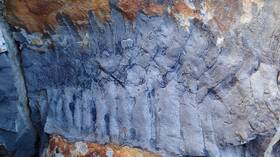Ancient millipedes could have been ‘as big as a car’

Giant millipedes the size of a vehicle once slithered across north England before the age of the dinosaurs, a new study has revealed after scientists discovered the creature’s 326-million-year-old fossilized remains.
The creature, named Arthropleura, is believed to have broken the record for the largest-known arthropod, a grouping of invertebrates that includes insects and small sea creatures. But the fossil is thought to be only one section of a creature “as big as a car,” according to the authors of a paper published on Tuesday in the Journal of the Geological Society.
Researchers believe the 75-centimeter-long specimen represents a portion of Arthropleura’s exoskeleton that was shed near a river bed and then preserved by sand. The creature’s total length is estimated to have been 2.7-metres (about nine feet) and it would have weighed about 50kg (roughly 110 pounds).
The remains – the oldest ever found – date back to the Carboniferous Period, more than 100 million years before dinosaurs roamed the Earth. At the time, the landmass that would become the UK was positioned near the equator and enjoyed warm temperatures.
Arthropleura’s size has previously been attributed to the higher oxygen concentration in the atmosphere at the time but the discovery suggests that the creature must have had a plant diet rich in nutrients. It may have also been a predator, preying on other invertebrates and small amphibians.
The fossil was found in January 2018 after a section of sandstone cliff fell onto the shore of a beach in Northumberland, near the border with Scotland. A group led by the study’s lead author, Neil Davies, an Earth scientist at Cambridge, stumbled on the find by “complete fluke.”
Noting that the specimen was “so large it took four of us to carry it up the cliff,” Davies said the lack of a complete set of remains – including a “fossilized head” – makes it “difficult to know everything about them.”
Arthropleura are thought to have gone extinct after about 45 million years due to reasons that are not yet clear. Theories include drier climates due to global warming and the rise of reptiles, who competed with them for food in the same areas.














